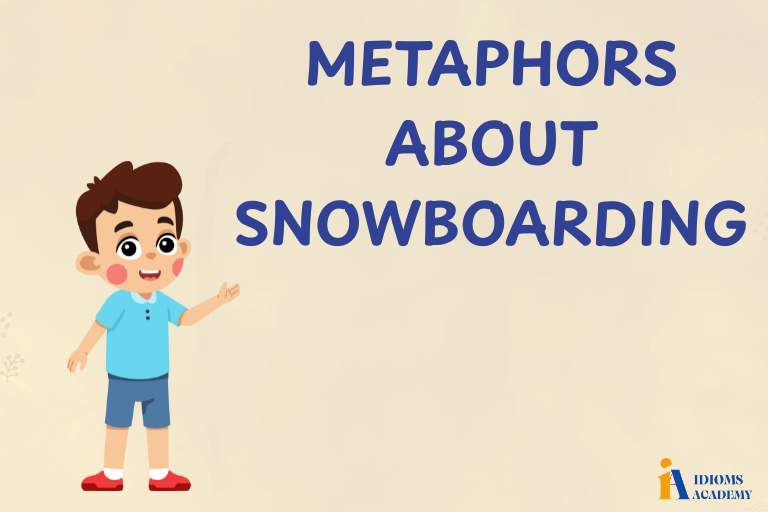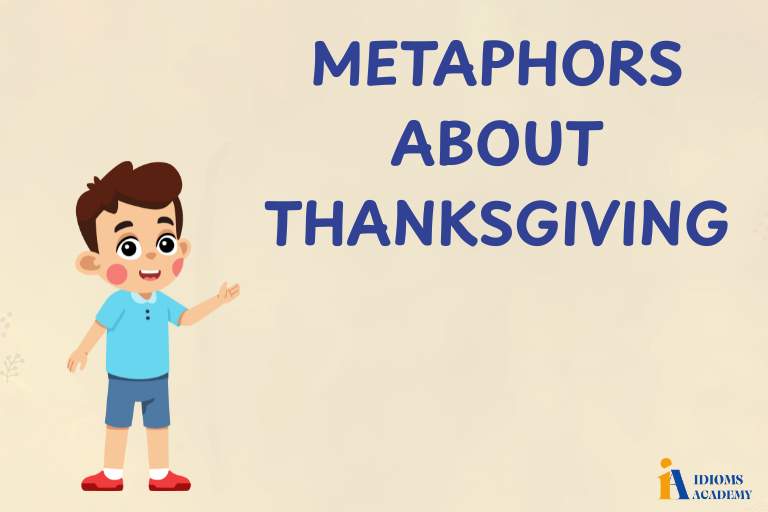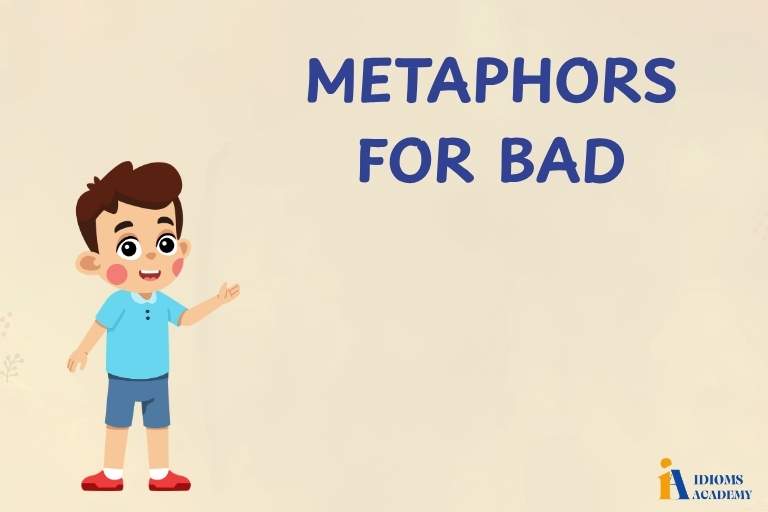Writing is more than just putting words on paper. It can feel like painting a picture, building a house, or going on a journey. People often use metaphors to help explain what writing feels like. These comparisons can make writing easier to understand and more fun to talk about.
In this article, we will explore some common metaphors people use to talk about writing. Each one shows a different way people think about the process. Some show writing as hard work, while others make it sound like play. Let’s take a closer look and see how these ideas can help us better understand what writing is really like.
Metaphors About Writing
1. Writing is like painting a picture
Meaning: Writing helps people see ideas clearly, like how a picture shows a scene.
Example Sentence:
- She used words to paint a picture of her summer vacation.
- His story painted a picture of life on a farm.
Other ways to say:
- Drawing with words
- Making a word picture
Fun Fact/Origin: This idea connects writing to art. Painters use colors to show things. Writers use words to do the same in the reader’s mind.
Usage: Use this when writing helps people imagine something clearly.
2. Writing is a journey
Meaning: Writing moves from one idea to another, like taking a trip.
Example Sentence:
- Writing this report felt like a long trip through history.
- Her poem took us on a journey through her thoughts.
Other ways to say:
- Word trip
- Story path
Fun Fact/Origin: People often call learning or creative work a “journey.” The idea is that you keep moving forward, step by step.
Usage: Use this when writing is long or takes effort over time.
3. Writing is building a house
Meaning: Writing has parts like a house—foundation, structure, and details.
Example Sentence:
- He built his essay like a house, with a strong beginning and neat ending.
- Each paragraph was a brick in the wall of his report.
Other ways to say:
- Word construction
- Story framework
Fun Fact/Origin: Builders use plans and tools. Writers do, too. This idea shows how writing needs good planning and support.
Usage: Use this when writing has steps, structure, and careful planning.
4. Writing is planting a seed
Meaning: A small idea can grow into something big, like a tree from a seed.
Example Sentence:
- Her poem started as a small idea but grew into something great.
- A single sentence planted the seed for his whole story.
Other ways to say:
- Growing a story
- Idea garden
Fun Fact/Origin: This comes from farming. A tiny seed needs care to grow. Writing needs care, too.
Usage: Use this when an idea starts small and gets bigger through writing.
5. Writing is cooking a meal
Meaning: Writing mixes parts together, like ingredients in a recipe.
Example Sentence:
- His story mixed action and humor like a good soup.
- She cooked up a fun tale with just a few lines.
Other ways to say:
- Story recipe
- Mixing words
Fun Fact/Origin: Cooks use recipes to make food. Writers follow steps to make a good piece. Both need balance and taste.
Usage: Use this when writing brings different ideas or parts together in a smooth way.
6. Writing is like a mirror
Meaning: Writing can reflect a person’s thoughts and feelings.
Example Sentence:
- Her journal was a mirror of her heart.
- His essay showed a clear picture of his mind.
Other ways to say:
- Word reflection
- Thought mirror
Fun Fact/Origin: Mirrors show the outside. Writing can show the inside—our ideas and feelings.
Usage: Use this when writing shows what someone is thinking or feeling.
7. Writing is a puzzle
Meaning: Writing brings different pieces together to make a whole.
Example Sentence:
- He put the puzzle of his story together piece by piece.
- Each paragraph was a part of the big picture.
Other ways to say:
- Word puzzle
- Story pieces
Fun Fact/Origin: Like puzzles, writing needs the right parts in the right place to make sense.
Usage: Use this when writing has many parts that fit together.
8. Writing is like music
Meaning: Writing has rhythm, tone, and flow, just like music.
Example Sentence:
- Her words sang across the page.
- His poem had a nice beat and smooth tone.
Other ways to say:
- Word melody
- Sentence rhythm
Fun Fact/Origin: Writers, like musicians, often read their work out loud to hear how it sounds.
Usage: Use this when writing sounds nice or flows well.
9. Writing is like a map
Meaning: Writing helps guide readers from one idea to the next.
Example Sentence:
- The report gave a clear map of the problem.
- Her story mapped out every step of the adventure.
Other ways to say:
- Word guide
- Story path
Fun Fact/Origin: Maps show direction. Good writing shows where to go next in the story or idea.
Usage: Use this when writing helps explain or guide.
10. Writing is a tool
Meaning: Writing helps us do things—share, explain, or teach.
Example Sentence:
- Writing is a tool he uses to speak his mind.
- She used writing to fix a misunderstanding.
Other ways to say:
- Word tool
- Story device
Fun Fact/Origin: Tools help with work. Writing helps with thinking and solving problems.
Usage: Use this when writing is used to get something done.
11. Writing is weaving a tapestry
Meaning: Writing connects many ideas into one big story.
Example Sentence:
- Her book wove many stories into one.
- He wove facts and feelings into his speech.
Other ways to say:
- Word weaving
- Story thread
Fun Fact/Origin: A tapestry is made by weaving threads. Writing can “weave” ideas the same way.
Usage: Use this when writing connects many parts smoothly.
12. Writing is like sculpting
Meaning: Writing shapes rough ideas into something clear.
Example Sentence:
- He shaped his messy notes into a strong essay.
- She chipped away until her story was just right.
Other ways to say:
- Word carving
- Idea shaping
Fun Fact/Origin: Sculptors remove what’s not needed. Writers often do the same by editing.
Usage: Use this when writing changes a rough draft into something better.
13. Writing is planting a flag
Meaning: Writing shows your thoughts and stands for something.
Example Sentence:
- She planted her flag on the topic of school lunch.
- His opinion piece was bold and clear.
Other ways to say:
- Making a stand
- Word statement
Fun Fact/Origin: Planting a flag often means claiming a place. In writing, it means taking a clear stand.
Usage: Use this when writing clearly shows a strong idea or opinion.
14. Writing is lighting a candle
Meaning: Writing can bring light or understanding to others.
Example Sentence:
- His story lit a candle in her mind.
- The article helped shine light on the issue.
Other ways to say:
- Bright idea
- Word light
Fun Fact/Origin: Candles help people see in the dark. Writing can help people see new ideas.
Usage: Use this when writing teaches or explains something clearly.
15. Writing is like flying a kite
Meaning: Writing can be fun and free, but still needs control.
Example Sentence:
- Her imagination flew high like a kite.
- His story lifted off with ease.
Other ways to say:
- Word flight
- Free writing
Fun Fact/Origin: A kite flies with wind and string. Writing needs both freedom and guidance too.
Usage: Use this when writing is creative but also focused.
16. Writing is opening a window
Meaning: Writing lets others see into your world.
Example Sentence:
- Her story opened a window into her life.
- His essay gave a view into his thoughts.
Other ways to say:
- Word window
- Story view
Fun Fact/Origin: Windows let in light and show the outside. Writing can do that with ideas and feelings.
Usage: Use this when writing helps people understand someone else’s view.
17. Writing is baking a cake
Meaning: Writing takes time, steps, and the right mix to work well.
Example Sentence:
- She followed each step to bake her writing “cake.”
- His report rose slowly but turned out sweet.
Other ways to say:
- Word recipe
- Story bake
Fun Fact/Origin: Like baking, writing needs careful steps and timing to turn out right.
Usage: Use this when writing follows steps and needs the right mix.
18. Writing is building a bridge
Meaning: Writing connects people or ideas.
Example Sentence:
- His letter built a bridge between two groups.
- The book helped connect old ideas to new ones.
Other ways to say:
- Word bridge
- Idea link
Fun Fact/Origin: Bridges join two places. Writing can join different people or thoughts.
Usage: Use this when writing helps people come together or understand each other.
19. Writing is like a camera
Meaning: Writing can freeze a moment or picture a scene.
Example Sentence:
- Her words snapped a picture of the moment.
- His story captured the scene like a photo.
Other ways to say:
- Word snapshot
- Story frame
Fun Fact/Origin: Cameras take photos. Writing can do the same with words.
Usage: Use this when writing captures a moment clearly.
20. Writing is like a key
Meaning: Writing unlocks ideas or solves problems.
Example Sentence:
- His essay was the key to understanding the topic.
- Her words unlocked the truth.
Other ways to say:
- Idea key
- Unlocking words
Fun Fact/Origin: Keys open doors. Writing can open new thinking or help fix problems.
Usage: Use this when writing helps explain, open, or fix something.
21. Writing is a snowball
Meaning: A small idea can grow as you keep writing.
Example Sentence:
- His story started small but rolled into something big.
- Her report kept growing like a snowball.
Other ways to say:
- Idea buildup
- Rolling thoughts
Fun Fact/Origin: Snowballs grow as they roll. Writing can grow the same way.
Usage: Use this when writing gets bigger or stronger as it goes.
22. Writing is a mirror maze
Meaning: Writing can reflect many angles and be tricky to follow.
Example Sentence:
- His story had twists like a mirror maze.
- Her ideas bounced around and surprised the reader.
Other ways to say:
- Word maze
- Thought trap
Fun Fact/Origin: Mirror mazes reflect many views. Some writing shows many sides too.
Usage: Use this when writing has complex or twisting ideas.
23. Writing is fishing
Meaning: Writing is about catching ideas and holding on to them.
Example Sentence:
- He cast his net and caught a great idea.
- Her notebook was full of story “fish.”
Other ways to say:
- Idea catching
- Word hunt
Fun Fact/Origin: Fishing takes time and patience. So does writing.
Usage: Use this when writing is about finding and keeping good ideas.
24. Writing is a magic trick
Meaning: Writing can surprise or amaze people.
Example Sentence:
- Her twist ending felt like a magic trick.
- His words made the ordinary seem magical.
Other ways to say:
- Word magic
- Story spell
Fun Fact/Origin: Magicians use tricks to wow people. Writers can do that with words.
Usage: Use this when writing surprises, entertains, or amazes.
25. Writing is digging for treasure
Meaning: Writing means looking deep to find the best ideas.
Example Sentence:
- He dug deep to find the heart of his story.
- Her writing uncovered a hidden gem.
Other ways to say:
- Idea digging
- Story treasure
Fun Fact/Origin: Treasure hunting is hard work. Writing can be too, but it can lead to great things.
Usage: Use this when writing brings up valuable or hidden ideas.
26. Writing is painting with words
Meaning: Writing creates pictures in the reader’s mind.
Example Sentence:
- Her words painted a picture of the beach.
- He used writing to color his world.
Other ways to say:
- Word painting
- Language art
Fun Fact/Origin: Writers use words like painters use brushes—to show something clearly.
Usage: Use this when writing helps people “see” a scene or feeling.
27. Writing is planting seeds
Meaning: Writing starts ideas that grow over time.
Example Sentence:
- Her essay planted ideas that grew in people’s minds.
- His story started small but grew big.
Other ways to say:
- Idea seeds
- Thought garden
Fun Fact/Origin: Like seeds, good writing grows and spreads if cared for.
Usage: Use this when writing leads to more thinking or learning later.
28. Writing is a jigsaw puzzle
Meaning: Writing puts different pieces together to make a full picture.
Example Sentence:
- His report fit all the pieces just right.
- Her story clicked together like a puzzle.
Other ways to say:
- Word puzzle
- Thought pieces
Fun Fact/Origin: Puzzles need patience and planning—just like writing.
Usage: Use this when writing needs careful parts to make sense.
29. Writing is a time machine
Meaning: Writing can take you to the past or future.
Example Sentence:
- Her book took us back to the 1800s.
- His story showed what life might be like in 2090.
Other ways to say:
- Story time-travel
- Word trip
Fun Fact/Origin: Writing lets you imagine or visit different times through reading.
Usage: Use this when writing brings readers to other times.
30. Writing is building with blocks
Meaning: Each word or sentence adds to the whole story.
Example Sentence:
- She built her essay one word at a time.
- His story stood strong like a block tower.
Other ways to say:
- Word tower
- Sentence stack
Fun Fact/Origin: Like toy blocks, writing stacks parts to make something new.
Usage: Use this when writing grows piece by piece.
31. Writing is a flashlight
Meaning: Writing can light up dark or hidden ideas.
Example Sentence:
- His article helped shine light on a hard topic.
- Her story helped people understand something they didn’t before.
Other ways to say:
- Word light
- Idea beam
Fun Fact/Origin: Flashlights show what we couldn’t see. Writing can do that with thoughts.
Usage: Use this when writing helps explain something clearly.
32. Writing is a voice in a bottle
Meaning: Writing lets your thoughts travel to someone far away or later.
Example Sentence:
- His letter was like a voice in a bottle.
- Her words reached people across the country.
Other ways to say:
- Story message
- Word bottle
Fun Fact/Origin: Messages in bottles were once tossed into the sea. Writing can reach others too—even in time.
Usage: Use this when writing is meant to be shared or passed on.
33. Writing is like weaving a blanket
Meaning: Writing combines many parts into one strong piece.
Example Sentence:
- Her report wove facts and feelings together.
- His story wrapped you up like a warm blanket.
Other ways to say:
- Story weave
- Word fabric
Fun Fact/Origin: Blankets are made by weaving threads—writing weaves ideas.
Usage: Use this when writing blends many things into one story.
34. Writing is like a road map
Meaning: Writing gives readers a path to follow.
Example Sentence:
- His article showed a clear path through a big idea.
- Her story guided the reader from start to end.
Other ways to say:
- Idea map
- Word path
Fun Fact/Origin: Maps show where to go. Writing helps readers move through thoughts.
Usage: Use this when writing is clear and helps people understand steps.
35. Writing is a rocket
Meaning: Writing can launch ideas and go far fast.
Example Sentence:
- Her poem took off like a rocket.
- His ideas flew off the page.
Other ways to say:
- Idea launch
- Word blast
Fun Fact/Origin: Rockets move quickly and reach far places—like good writing can.
Usage: Use this when writing has speed, energy, or travels far.
36. Writing is a heartbeat
Meaning: Writing can show deep feelings and life.
Example Sentence:
- Her story had heart.
- His writing beat with strong emotion.
Other ways to say:
- Word pulse
- Story life
Fun Fact/Origin: The heart keeps us alive. Writing with feeling keeps stories alive.
Usage: Use this when writing has strong emotions or passion.
37. Writing is a tightrope walk
Meaning: Writing needs balance—too much or too little ruins it.
Example Sentence:
- Her story walked the line between funny and serious.
- He balanced facts and fun well.
Other ways to say:
- Word balance
- Idea line
Fun Fact/Origin: Tightrope walkers must stay steady. Writers do too with tone and ideas.
Usage: Use this when writing must keep different parts in balance.
38. Writing is a seed vault
Meaning: Writing can store ideas for the future.
Example Sentence:
- Her notebook was full of saved thoughts.
- His journal kept seeds for later stories.
Other ways to say:
- Idea bank
- Word saver
Fun Fact/Origin: Real seed vaults protect plants. Writing protects thoughts.
Usage: Use this when writing saves ideas to use later.
39. Writing is a quilt
Meaning: Writing pieces together to make one story.
Example Sentence:
- Her essay stitched quotes and thoughts into one.
- His paper was a patchwork of ideas.
Other ways to say:
- Story quilt
- Idea patchwork
Fun Fact/Origin:
Quilts are made from many pieces. So is writing.
Usage: Use this when writing brings together different things.
40. Writing is a roller coaster
Meaning: Writing can have ups, downs, and surprises.
Example Sentence:
- Her story had highs and lows that kept me reading.
- His book was full of fun twists.
Other ways to say:
- Word ride
- Story loop
Fun Fact/Origin: Roller coasters move fast and change suddenly—some stories do too.
Usage: Use this when writing has energy and surprises.
41. Writing is a puzzle box
Meaning: Writing may hide something that needs to be figured out.
Example Sentence:
- His poem was like a puzzle you had to solve.
- Her story had a secret inside.
Other ways to say:
- Word riddle
- Story clue
Fun Fact/Origin: Puzzle boxes need the right moves. Writing can need the right thinking.
Usage: Use this when writing is mysterious or tricky.
42. Writing is a river
Meaning: Writing can flow smoothly and carry readers along.
Example Sentence:
- Her words flowed like a river.
- His story moved gently from start to end.
Other ways to say:
- Word flow
- Idea stream
Fun Fact/Origin: Rivers move and change, just like writing can.
Usage: Use this when writing is smooth and steady.
43. Writing is a gift
Meaning: Writing is something you give to others.
Example Sentence:
- His poem was a gift to his mom.
- Her story gave joy to her class.
Other ways to say:
- Word present
- Story share
Fun Fact/Origin: Gifts show care. Writing can show love or thanks too.
Usage: Use this when writing is meant for someone else.
44. Writing is a ladder
Meaning: Writing helps you climb higher in thinking or learning.
Example Sentence:
- Each draft helped her climb to a better paper.
- His ideas got stronger step by step.
Other ways to say:
- Word steps
- Idea climb
Fun Fact/Origin: Ladders help you reach high places. So can writing.
Usage: Use this when writing helps you grow or learn more.
45. Writing is a mirror
Meaning: Writing can show who you are or reflect your thoughts.
Example Sentence:
- Her story showed her feelings like a mirror.
- His words reflected what he was going through.
Other ways to say:
- Word reflection
- Story image
Fun Fact/Origin: Mirrors show what’s real. Writing can show true thoughts too.
Usage: Use this when writing shows personal truth or feelings.
Quiz: Metaphors About Writing
Instructions: Choose the correct meaning for each metaphor. Each question has one correct answer. Use what you’ve learned from the metaphors to find the best choice.
Question Key
1. If someone says, “Writing is painting with words,” what does that mean?
A) Writing makes people want to paint.
B) Writing helps readers picture things clearly.
C) Writing is about coloring pages.
2. “Writing is a roller coaster” means what?
A) Writing is scary.
B) Writing is full of ups and downs and surprises.
C) Writing only goes fast.
3. When someone says, “Writing is a puzzle,” what do they mean?
A) Writing is hard and not fun.
B) Writing only has one right answer.
C) Writing needs pieces to fit together to make sense.
4. “Writing is a gift” means:
A) You wrap your notebook in paper.
B) You give your thoughts to someone through writing.
C) You get presents for writing.
5. What does “Writing is a mirror” tell us?
A) Writing helps you fix your hair.
B) Writing reflects your feelings and who you are.
C) Writing only shows other people’s lives.
6. If writing is called a “flashlight,” what is it doing?
A) Helping you see in the dark.
B) Lighting up ideas or helping people understand.
C) Turning off other thoughts.
7. “Writing is planting seeds” means:
A) You plant flowers while writing.
B) You write about plants.
C) You start ideas that grow over time.
8. Why might someone say, “Writing is a river”?
A) It’s long and boring.
B) It can flow smoothly and take readers along.
C) It only works with water topics.
9. If “Writing is a time machine,” what can writing do?
A) Let you ride in a car.
B) Help you write faster.
C) Take readers to the past or future.
10. “Writing is a ladder” means:
A) You climb while writing.
B) Writing helps you grow or reach new ideas step by step.
C) You can only write about tall things.
Answer Key
- B – Writing helps readers picture things clearly.
- B – Writing is full of ups and downs and surprises.
- C – Writing needs pieces to fit together to make sense.
- B – You give your thoughts to someone through writing.
- B – Writing reflects your feelings and who you are.
- B – Lighting up ideas or helping people understand.
- C – You start ideas that grow over time.
- B – It can flow smoothly and take readers along.
- C – Take readers to the past or future.
- B – Writing helps you grow or reach new ideas step by step.
Wrapping Up
Writing can be explained in many fun ways. Metaphors help us think about writing in pictures. They show how writing feels, grows, or moves.
When we say writing is a mirror, a bridge, or a garden, we understand it better. These ideas make writing easier to talk about and more fun to learn. Try using some of these when you write or read. It might help your thoughts grow stronger.




